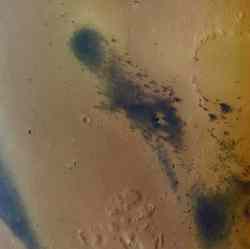Color picture of Gusev crater. Image credit: ESA
Click to enlarge
A large team of NASA scientists, led by earth and planetary scientists at Washington University in St. Louis details the first solid set of evidence for water having existed on Mars at the Gusev crater, exploration site of the rover Spirit.
Using an array of sophisticated equipment on Spirit, Alian Wang, Ph.D., Washington University senior research scientist in earth and planetary sciences in Arts & Sciences, and the late Larry A. Haskin, Ph.D., Ralph E. Morrow Distinguished University Professor of earth and planetary sciences, found that the volcanic rocks at Gusev crater near Spirit's landing site were much like the olivine-rich basaltic rocks on Earth, and some of them possessed a coating rich in sulfur, bromine, chlorine and hematite, or oxidized iron. The team examined three rocks and found their most compelling evidence in a rock named Mazatzal.
The rock evidence indicates a scenario where water froze and melted at some point in Martian history, dissolving the sulfur, chlorine and bromine elements in the soil. The small amount of acidic fluids then react with the rocks buried in the soil and formed these highly oxidized coatings.
Trench-digging rover
During its traverse from landing site to Columbia Hills, the rover Spirit dug three trenches, allowing researchers to detect relatively high levels of magnesium sulfate comprising more than 20 percent of the regolith ? soil containing pieces of small rocks ? within one of the trenches, the Boroughs trench. The tight correlation between magnesium and sulfur indicates an open hydrologic system ? these ions had been carried by water to this site and deposited.
Spirit's fellow rover Opportunity earlier had detected a history of water at another site on Mars, Meridiani planum. This study (by Haskin et al.) covered the investigation of Spirit rover sols (a sol is a Martian day) 1 through 156, with the major discoveries occurring after sol 80. After the findings were confirmed, Spirit traversed to the Columbian hills, where it found more evidence indicating water. The science team is currently planning for sol 551 operation of Spirit rover, which is only 55 meters away from the summit of Columbia Hills.
Spirit was on sol 597 on Sept 6 and on the summit of Husband Hill.
"We will stay on the summit for a few weeks to finish our desired investigations, then go downhill to explore the south inner basin, especially the so-called 'home-plate,' which could be a feature of older rock or a filled-in crater," Wang said. "We will name a major geo-feature in the basin after Larry."
Buried again and again
"We looked closely at the multiple layers on top of the rock Mazatzal because it had a very different geochemistry and mineralogy," said Wang. "This told us that the rock had been buried in the soil and exposed and then buried again several times over the history. There are chemical changes during the burial times and those changes show that the soil had been involved with water.
"The telltale thing was a higher proportion of hematite in the coatings. We hadn't seen that in any previous Gusev rocks. Also, we saw very high chlorine in the coating and very high bromine levels inside the rock. The separation of the sulfur and chlorine tells us that the deposition of chlorine is affected by water."
While the multilayer coatings on rock Mazatzal indicates a temporal occurrence of low quantity water associated with freezing and melting of water, the sulfate deposition at trench sites indicates the involvement of a large body of water.
"We examined the regolith at different depths within the Big Hole and the Boroughs trenches and saw an extremely tight correlation between magnesium and sulfur, which was not observed previously," Wang said. "This tells us that magnesium sulfate formed in these trench regoliths. The increasing bromine concentration and the separation of chlorine from sulfur also suggests the action of water. We don't know exactly how much water is combined with that. The fact that the magnesium sulfate is more than 20 percent of the examined regolith sample says that the magnesium and sulfur were carried by water to this area from another place, and then deposited as magnesium sulfate. A certain amount of water would be needed to accomplish that action."
WUSTL News Release
 Universe Today
Universe Today
